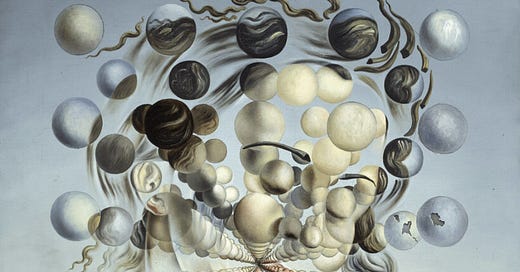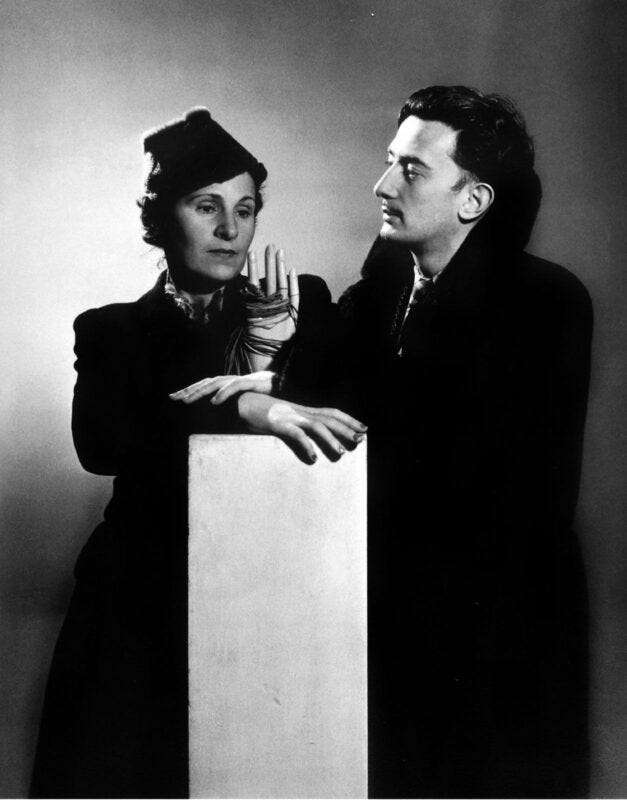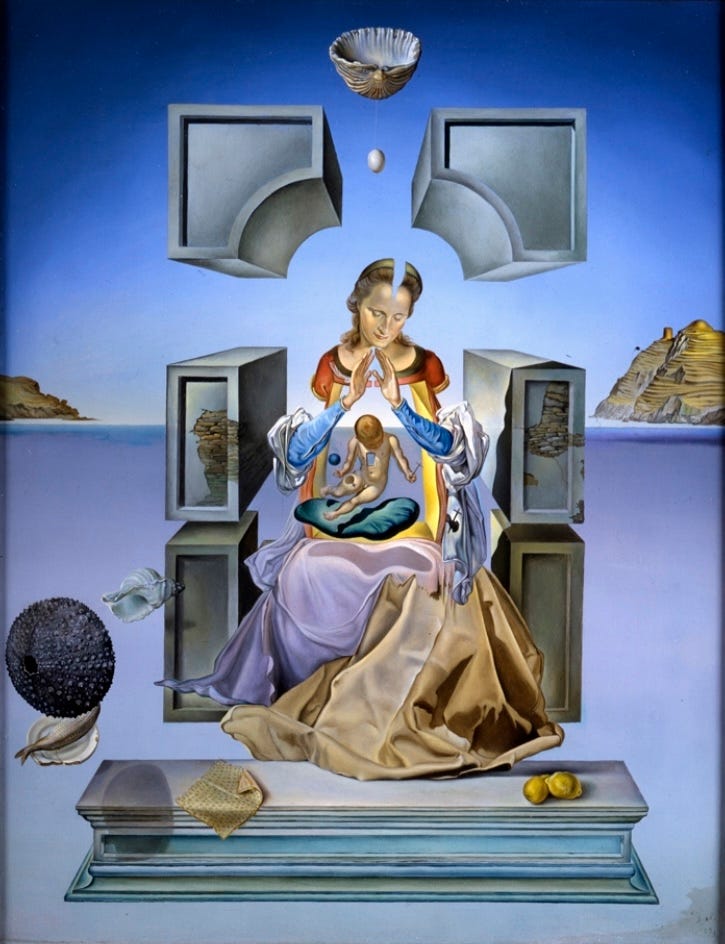My most recent novel, In the Garden of Monsters, is a wild story that includes Hades and Persephone, Italy’s Sacro Bosco stone statue garden of monsters, and the most famous artist of the 20th century, Salvador Dalí—and his wife, Gala. I know, it’s a lot. But I did say it’s a wild story. Un ‘po pazzo, the Italians might say. But the myths are often surreal, and the garden certainly is, and well, of course, Dalí is the most surreal of it all.
But his wife, Gala, is the cog in the wheel behind the scenes. Without her, Dalí would probably not have amounted to much. But she knew how to channel his talent, and she was the one who helped him charm and captivate the world.
There’s a new novel out about Gala, SURREAL: The Extraordinary Life of Gala Dalí, by Michèle Gerber Klein. I wonder how different my novel might have been if I had read this before I sat down to write. Information about Gala’s personal life has been scant, overshadowed by everything related to her second husband, Salvador Dalí. Klein’s book shines the light on Gala, giving her the attention which was due to her decades past. She details Gala’s life from birth to death, tracing Gala’s transformation from muse to powerbroker. She was an iron-willed architect behind Dalí’s success, not just a presence in the background. She handled business deals, shaped his persona, and even signed some of his works. I learned so much about her life, and I truly enjoyed reading the book. It’s well-written, and well-researched, and I honestly recommend it to anyone who wants to know more about her, and her relationship with Dalí. I’m not a literary critic, and I normally never say anything about a book if I can’t give it a million stars, because books are subjective. But in this case, I feel it important to point out what is missing.
There has been a trend in the last decade or two to tell the woman’s side of the story. I appreciate this in so many ways. Women have been badly maligned in history, and many who have the reputation of being villains (Livia, Augustus Caesar’s wife comes to mind), might not have been. But women aren’t infallible, and Gala Dalí was certainly not.
While Klein's book offers a valuable and much-needed spotlight on Gala, it shies away from a full exploration of her more controversial traits, which were frequently noted by her contemporaries. Accounts from those who knew her paint a picture of a woman whose personality was as sharp and unyielding as her business acumen.
Let’s start with Gala's relationship with her only child, Cécile. Born in 1918 to Gala and her first husband, Paul Éluard, Cécile's life with her mother was marked by profound distance. Their relationship was estranged, and while Klein mentions this, she glosses it over, almost as though it was something normal for a mother to do to her child, rather than a deeply significant aspect of Gala's character. After divorcing Éluard in 1932 and marrying Dalí in 1934, Gala happily abandoned Cécile to Éluard’s sole care. She had little to do with Cécile throughout her life, and Gala even explicitly disapproved of Cécile's marriage in 1938. Cécile herself said that, “After she met Dalí in 1929, she was not interested in me any more.” Cécile was only 11 when Gala abandoned both husband and daughter. Gala often went years without talking to her daughter at all, even during a time when, as author Francine Prose points out in her book, The Lives of the Muses: Nine Women & the Artists They Inspired, Dalí was painting Gala as the Madonna, the most holy mother of all. Prose also tells us, “After Eluard died, Gala informed Cecile—to whom she had not spoken in four years—that she did not wish to communicate with her ever again.”
Even when Cécile Éluard, reading about her mother’s distress in the Paris newspapers, traveled to visit her in Port Lligat during Gala’s final illness—a time when Gala was likely experiencing dementia and only dimly remembered her daughter—the narrative, as presented by Klein, seems to avoid the deeper emotional weight. The maid’s cold refusal, “‘She said that was a very long time ago,’” and the subsequent turning away of a heartbroken daughter, is recounted as a factual event, yet without the necessary introspection into what this final, tragic disconnect reveals about a lifetime of emotional detachment. It's in these moments that the book's narrative underplays the unsettling reality of Gala's complex and often harsh personal relationships.
Beyond her familial detachment, Gala's social conduct was notoriously abrasive. Amanda Lear describes Gala multiple times in her memoir, Persistence of Memory. One of the earliest descriptions of Gala in the book is of Dalí telling her about his wife.
“Gala herself is like a bee. She comes, she stings, and then she flies away immediately.” Gala did, in fact, leave us shortly afterwards, visibly irritated by the mediocrity of the company and the platitudes of the conversation.
Amanda describes her:
“I found her unbearable. She didn’t say a single nice thing to me and tried hard to ignore me. She seemed to live in a world light years away from Dalí’s, one that revolved around practical matters. The Cadillac needed repairing; the chauffeur was too expensive; she had called Cadaqués, the heat wasn’t working. “
And,
“never once did I see her make the slightest effort to be nice to anybody. She was often aggressive, and would make mocking remarks about a man’s long hair, or the chest of a model. Most of all, it was folly to talk to her about contemporary literature: everything was rubbish and badly written. On the other hand, she never missed a chance to praise her husband’s genius. Dalí was unique, the only one who could paint and write, the only one who had any talent.”
Amanda’s account is one of many. As Nina-Sophia Miralles tells us in The Paris Review:
At her best, Gala was difficult and intense. At her worst, she was nothing short of monstrous. She had no friends and maintained a malevolent distance from her family. Described as “cruel, fierce and small” and having “eyes that pierced walls,” she collected stuffed toys but once cooked her own pet rabbit. Her “demonic temper” asserted itself often; if she didn’t like someone’s face, she spat at them, and if she wanted to silence someone, she would stub cigarettes out on their arm. Not surprisingly, she was hugely unpopular. Women particularly disliked her. Gala was sexually voracious and had no respect for other people’s relationships. Dealers in Paris nicknamed her Gala la Gale—gale means both “a spiteful person” and “scabies.” The filmmaker Luis Buñuel, who, with Dalí, made the seminal short film Un chien Andalou, got so sick of Gala’s insults that he once tried to throttle her. In a 1998 Vanity Fair article rife with gendered language that now feels blessedly dated, John Richardson, one of Dalí’s art dealers in the early seventies, refers to Gala as an “ancient harridan,” “an authentically Sadean monster,” a “demonic dominatrix,” a “scarlet woman,” and as having “an appetizing little body, and the libido of an electric eel.”
While Klein mentions some of these episodes, such as the situation with Buñuel, there is no real exploration of the pattern of cruelty and abrasion that defined Gala’s interactions with most people, especially later in her life. Her formidable personality, so beneficial in Dalí’s career, often manifested as sheer ruthlessness in her personal dealings.
Gala’s personal life was just as provocative as her artistic circle. Throughout her marriage to Dalí, she maintained numerous relationships with other men. Dalí was not only aware of these affairs, but by many accounts, he accepted them and actively encouraged them. Their dynamic, often described in anecdotes by people that knew the couple, challenges conventional ideas of fidelity and partnership. He was a voyeur, and liked to watch his wife and her paramours, a well-documented fact that Klein ignores. What’s striking is that while Klein chronicles Gala’s life in rich detail, much of this more controversial undercurrent is left untouched. Her sexual independence and their unusual sexual agreement was frequently noted by contemporaries, and Dalí’s unusual relationship to it adds a layer of complexity that is hard to ignore.
The film Daliland portrays this side of them in a way that, to me, feels faithful to the many accounts I have read about the couple. And Ben Kingsley is always worth a watch.
Gala’s influence on Dalí’s financial ventures was also a source of significant controversy. While she was undeniably a brilliant businesswoman who helped propel Dalí to immense wealth, rumors persisted that some of their financial dealings pushed ethical boundaries. One of the most notorious examples was the “blank canvas” scandal—Dalí signing thousands of blank sheets of paper, later used for prints, many of which were poor quality or outright forgeries. Klein’s research suggests Gala wasn’t directly involved. The deal, she says, was arranged between Dalí, publisher Pierre Argillet, and assistant Peter Moore, who even negotiated extra payment per signature. Since Dalí signed only his own name, Klein argues Gala’s approval wasn’t required and attributes the scheme’s fallout entirely to Moore.
But the profits were enormous; Dalí reportedly earned $100,000 in a single day, which Klein notes were paid in Gala’s preferred $100 bills. And yet, strangely, in the very next sentence Klein asserts that Gala was not involved in the scheme. And throughout the book, Klein documents Gala’s obsessive control over their finances, including multiple undeclared accounts, making it hard to believe she was entirely unaware of where this money was coming from. When the scheme collapsed in 1974, exposing over 40,000 forged sheets, the fallout included an IRS probe into Gala’s holdings. Her own lawyer traced missing funds back to Moore, who admitted taking money out of spite, claiming Gala had refused to pay him fairly. She promptly fired him. While Klein clearly distances Gala from the origin of the scandal, the scale of her benefit and her deep involvement in the couple’s finances raise questions that go unanswered. A more critical lens might have added valuable dimension to this part of Gala’s legacy.
In fairness to Klein, portraying the full, often unflattering, complexity of a historical figure like Gala Dalí is a challenging task. It's also important to consider the deeply misogynistic world she navigated; a world that often confined women to specific roles, making a woman like Gala, who was fiercely ambitious and financially astute, an anomaly and often a target of harsh criticism that might have been less severe if she were a man. However, in an effort to bring Gala out of Dalí’s shadow and celebrate her undeniable contributions, some of the darker, yet crucial, aspects of her personality and behavior appear to have been underplayed. Understanding Gala means acknowledging not only her transformative role as a muse and manager but also the challenging, and at times genuinely disturbing, facets of her character. It paints a more complete, albeit less flattering, picture of the woman who shaped one of the 20th century’s most iconic artists.
While I very much enjoyed and I recommend reading SURREAL: The Extraordinary Life of Gala Dalí, by Michèle Gerber Klein, it’s worth keeping in mind that it’s not the full story of this fascinating, complex, and powerful woman.
What’s Bringing Me Joy
I’m working on a new novel, set in the 80s, and this totally tubular Reddit thread about Gen-X sayings brought me so much nostalgia.
This poochie dancing to the music! Sound on!
This feels very relevant today:
Thanks for Joining Me
If you love food and love Italy, and haven’t read IN THE GARDEN OF MONSTERS, THE CHEF’S SECRET or FEAST OF SORROW, click the links to learn where to buy your copy! And now you can pre-order my latest, THE HAPPINESS COLLECTOR!
You can also follow me here: Website | Instagram | Facebook | Threads | Bluesky






![Paul, Gala, and Cécile Éluard [Gala does not look happy..] Paul, Gala, and Cécile Éluard [Gala does not look happy..]](https://substackcdn.com/image/fetch/$s_!t29M!,w_1456,c_limit,f_auto,q_auto:good,fl_progressive:steep/https%3A%2F%2Fsubstack-post-media.s3.amazonaws.com%2Fpublic%2Fimages%2F159bf9d8-bb58-4487-8bbc-79cdafe16943_470x525.jpeg)



Always love your commentary and thanks for the background info on your latest novel. Involved with it now and the background info gives me greater appreciation for the story.
Wow, and I thought Amanda Lear Was a bit “ over the top”